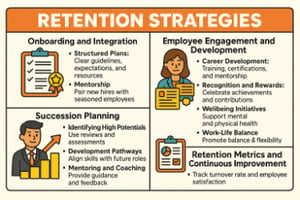Delivering the Key Components of a Successful Talent Management Strategy
Talent Acquisition and Recruitment
Attracting and hiring the right people, those with the skills, experience, and potential you need, is the first step in a successful talent management process. Key to effective talent acquisition and recruitment is:
- Defining Clear Job Roles and Requirements: Accurate and consistent job descriptions ensure applicants understand the skills and qualities needed for the role, preventing misalignment and setting realistic expectations. Basing these job descriptions on internationally accepted frameworks, such as Skills for the Information Age (SFIA) or the Data Capability Framework (DCF) further improve consistency, leading to improved applicant understanding of organisational skill and experience requirements.
- Leveraging Employer Branding: Promote your organisation’s values, culture, and opportunities to position it as an attractive place to work, especially through the advocacy of current staff. Creating a working culture which encourages current staff to actively and genuinely advocate for the organisation enhances authenticity and trust, positioning it as a desirable workplace for top talent.
- Utilising Diverse Recruitment Channels: Job boards, social media, employee referrals, and recruitment agencies all help to access a broad, diverse pool of candidates.
Onboarding and Integration
The onboarding process sets the tone for long-term staff engagement. A structured onboarding plan can make new hires feel welcome and ready to contribute from day one. Essential components include:
- Structured Plans: Clear guidelines, expectations, and resources help new employees hit the ground running. Usually taking the form of an onboarding desk file or new hire pack, this is a comprehensive resource provided to employees on their first day to facilitate a smooth transition into their new role, as well as providing a reference for the future.
- Mentorship: Pair new hires with seasoned employees to help them integrate into the company culture and processes.
- Regular Check-ins: Frequent one-on-one meetings ensure that new hires are adjusting well, and any issues are promptly addressed.
Performance Management
Effective performance management is an ongoing process that supports employees in achieving their best. Performance management is not only (or even mainly) about under-performance, but more about identifying and building on strengths. This includes:
- Setting Clear Goals: Establish measurable, achievable goals that align with the company’s broader objectives.
- Providing Regular Feedback: Continuous coaching and feedback help employees stay on track and improve over time.
- Performance Reviews: Formal evaluations should identify strengths and areas for growth, providing actionable insights for improvement.
Learning and Development
To retain top talent, organisations must invest in their growth. This skills and experience development might be focused on the next role in their pathway, or it may be in a new role they are interested in, or an identified future need of the organisation. This is achieved through:
- Ongoing Training: Offering continuous learning opportunities, whether to build new skills, stay updated on industry trends, or gain professional certifications.
- Personal Development Plans: Tailoring growth plans to individual employees' aspirations and the organisation's future needs.
- Leadership Development: Identifying and preparing high-potential employees for leadership roles through targeted training.
Succession Planning
Planning for the future is crucial for maintaining organisational continuity. Succession planning is the proactive process of identifying and developing internal talent to fill key leadership and critical roles within an organisation. By aligning future workforce needs with employee growth and development, succession planning ensures business continuity, reduces risk, and builds a resilient talent pipeline. Succession planning involves:
- Identifying Key Roles: Focus on critical positions where turnover would significantly impact the business.
- Developing Talent Pipelines: Ensure that high-potential employees are prepared to fill important roles through mentorship, training, and coaching.
- Creating Transition Plans: Establish clear strategies for passing on knowledge and responsibilities during role transitions.
Employee Engagement and Retention
Engaged employees are more likely to be productive, loyal, and invested in the organisation. To foster this:
- Promote a Positive Work Culture: Cultivate an inclusive and supportive environment where employees feel valued.
- Offer Competitive Compensation and Benefits: Ensure salaries and benefits are fair and improve employees’ quality of life.
- Recognise Contributions: Celebrate employees' efforts through recognition schemes, bonuses, and career advancement opportunities.
Offboarding
Effective offboarding is just as crucial as onboarding. It ensures a smooth transition and provides the opportunity to create a positive lasting impression for both the staff member and the organisation. A structured offboarding plan can maintain relationships and provide valuable insights. Essential components include:
- Knowledge Transfer: Systematic documentation and transfer of project details, key contacts, and responsibilities ensure continuity and minimize disruptions to team performance.
- Exit Interviews: Conducted to gather honest feedback, these interviews provide insights into employee experience and areas for organisational improvement.
- Transition Support: Offering career support, references, and alumni network access can leave a positive impact and create long-term advocates for the organisation.




